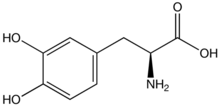From Wikipedia, the free encyclopedia
| Encephalitis lethargica | |
|---|---|
| Classification and external resources | |

First described by Constantin von Economo.
|
|
| ICD-10 | A85.8 |
| ICD-9 | 049.8 |
| DiseasesDB | 32498 |
Symptoms
Encephalitis lethargica is characterized by high fever, sore throat, headache, lethargy, double vision, delayed physical and mental response, sleep inversion and catatonia.[3] In severe cases, patients may enter a coma-like state (akinetic mutism). Patients may also experience abnormal eye movements ("oculogyric crises"),[7] parkinsonism, upper body weakness, muscular pains, tremors, neck rigidity, and behavioral changes including psychosis. Klazomania (a vocal tic) is sometimes present.[8]Postencephalitic parkinsonism may develop after a bout of encephalitis, more commonly in the post-encephalitic phase and often after a latent period of several years.
Cause
The cause of encephalitis lethargica is not known for certain.[9]Research in 2004 suggested that the disease is due to an immune reaction. In this study, many of the people with encephalitis lethargica had experienced recent pharyngitis and the authors found some evidence linking the reaction to prior streptococcal throat. They hypothesised that encephalitis lethargica, Sydenham's chorea and PANDAS (pediatric autoimmune neuropsychiatric disorders associated with streptococcal infections) are mediated by variations of the post-streptococcal immune response.[3]
There is also some evidence of an autoimmune origin with antibodies (IgG) from patients with encephalitis lethargica binding to neurons in the basal ganglia and mid-brain. Western immunoblotting showed that 95% of encephalitis lethargica patients had autoantibodies reactive against human basal ganglia antigens. By contrast, antibodies reactive against the basal ganglia were found in only 2-4% of child and adult controls (n = 173, P < 0.0001).[3]
Some researchers believe that new data supports the influenza hypothesis,[10] while others consider this less likely.[3]
Jang et al. (2009) at St. Jude Children's Research Hospital, USA, discovered that an H5N1 Bird Flu (strain A/VN/1203/1204) infection in mice causes severe loss of tyrosine-hydroxylase positive dopaminergic neurons 60 days after infection by provoking a destructive autoimmune response, thus suggesting the infection by certain strains of flu might increase the risk of Parkinson's disease in humans.[11] While Jang et al. (2009) acknowledge research that shows the virus that caused the 1918 flu pandemic (a type A influenza subtype H1N1) unlike H5N1 Bird Flu did not infect the brain, they propose that a distal infection might have provoked an autoimmune mediated destruction of dopaminergic neurons, while leaving no direct evidence of brain infection.[11]
Treatment
Treatment for encephalitis lethargica in the early stages is patient stabilization, which may be very difficult. There is little evidence so far of a consistent effective treatment for the initial stages, though some patients given steroids have seen improvement.[12] Other patients have been less fortunate, and the disease then becomes progressive, with evidence of brain damage similar to Parkinson's disease. Treatment is then symptomatic. Levodopa (L-DOPA) and other anti-parkinson drugs often produce dramatic responses. However, in most of the patients who were given L-DOPA in the 1960s, the amelioration of the disease was short lived.The course of encephalitis lethargica varies depending upon complications or accompanying disorders.
The prescription drug Zolpidem, commonly used as a sleeping pill, has been reported to be successful at treating encephalitis lethargica.[13][14]
Popular culture
Hawes, the curate in Agatha Christie's book The Murder at the Vicarage (1930), was described as suffering from this syndrome.The discovery by Oliver Sacks that L-DOPA could relieve some symptoms was described in his book Awakenings in 1973. The book was used by Harold Pinter as the basis of his one-act play A Kind of Alaska, performed in 1982 starring Judi Dench. Awakenings, a 1990 movie starring Robin Williams and Robert De Niro, is also based on the book. The Molly Caldwell Crosby book Asleep (2010) describes the history of the disease and the epidemic of the 1920s.[15] The 2012 novel, Umbrella, by Will Self centres on the occurrence of this disease and its later treatment with L-DOPA.
The Eighties US post-hardcore band Big Black recorded a song about the Encephalitis lethargica epidemic called "L-Dopa" (1987).
The disease plays a prominent role in the first issue of Neil Gaiman's comic book Sandman (as featured in The Sandman: Preludes and Nocturnes, Sandman: Doll's House, and Sandman Vol. 1, 1991); the disease, usually referred to by its nickname "sleepy sickness" and only once as its medical name, is attributed to the imprisonment of the sleep-master Dream in 1916 by an occultist.
The disease is researched and mentioned in the Canadian television show ReGenesis, in the last few episodes of the second series (2006). The disease is also involved in one of the episodes in the American science fiction television show Alphas, called a "A short time in paradise" (2011), in which the antagonist causes Encephalitis lethargica to afflict his victims.


No comments:
Post a Comment